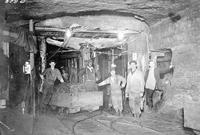Coal Mining, Vancouver Island
COAL MINING, VANCOUVER ISLAND, began at Beaver Harbour near the north end of the Island, where the HBC and Royal Navy ships traded coal from the local KWAKWAKA'WAKW. The HBC established FORT RUPERT in 1849, installing a party of 7 Scottish miners to put the operation on a more professional footing. The company was ill-prepared for the miners and their families, however. Food was inadequate and housing non-existent. Moreover, the underground coal deposits could not be reached without extensive work. Instead of mining, the miners were sinking shafts, prospecting for coal and doing general labourers' work. As a result they could not earn the bonuses for coal production they had been promised in Scotland, and the company would not renegotiate their contracts. Equally frustrating was the fact that the miners were used to being treated as tradesmen—skilled workers who controlled the pace and process of the work. HBC treated them as servants, as it did its own employees, who worked as hard and as long as the company dictated. In the end, the miners refused to work. Most of them left the colony for the California goldfields. They were replaced by new workers, but the mine was unsuccessful and closed in 1852. Meanwhile, in 1849 the SNUNEYMUXW (Nanaimo) people told the HBC about coal deposits in their territory. The company purchased 24 sq km from the Crown and put the Snuneymuxw to work collecting surface coal. Colliers from Fort Rupert moved south to NANAIMO in 1852 and began digging shafts. A decade later, HBC sold out to Vancouver Coal Mining and Land Co, which built BC's first railway in 1863, a short line linking the mines to the wharf at Nanaimo.
In 1869 Robert DUNSMUIR purchased property at WELLINGTON, north of Nanaimo, and developed another major mine. The third important island coal centre was the COMOX Valley. Coal was discovered at Comox in 1853 but serious development did not begin until the 1880s, when Dunsmuir acquired claims at CUMBERLAND and created the Union Colliery Co. The Cumberland mines were linked to UNION BAY by rail. By the mid-1890s the best coal at Wellington was played out and the operation was phased out by 1900. The town moved to LADYSMITH, on Oyster Harbour, which had become the trans-shipment centre for new mines developed by the Dunsmuir company at the small community of EXTENSION. By 1900 this mine was producing 360,000 tonnes a year. In 1910 James Dunsmuir sold the mines at Extension and Cumberland to2 railway promoters, Donald Mann and William Mackenzie, for $11 million. In turn they reorganized the operation and sold it to British entrepreneurs, who created Canadian Collieries (Dunsmuir) Ltd.
Meanwhile the other major player, Vancouver Coal Mining, was prospering at Nanaimo; the mines reached peak production in 1922 when over 1.25 million tonnes were shipped. It eventually changed its name to Western Fuel Corp of Canada and in 1928 sold to Canadian Collieries, giving that company a virtual monopoly on Island coal mining. During the Depression years there was a steady decline in production, which continued in the post-war period as OIL AND GAS rapidly replaced coal as a fuel. The Extension mines closed in 1931, followed by the last large-scale Nanaimo-area mines in the early 1950s. Mining continued at Cumberland until 1960. When the Tsable River mine south of Union Bay closed in 1966, it marked the end of 80 years of coal mining in the area. In 2005 the Quinsam mine near CAMPBELL RIVER was the Island's last coal producer.
The mine workforce was polyglot, consisting mainly of British immigrants with large numbers of CHINESE, JAPANESE and BLACK labourers, all paid less than their white comrades and all segregated in separate districts of the various mining communities. Underground mining was extremely dangerous work. Fires, flooding and cave-ins were all common. On 3 May 1887 an explosion and fire in the Vancouver Coal Co mine at Nanaimo killed 150 men. In 1888 another 77 men died in an explosion at Wellington. These were the worst accidents; there were many others. Chinese miners were blamed for the accidents and mine owners agreed not to hire Chinese labour underground (though they continued to work at Cumberland). Nanaimo miners were unionized, but attempts to organize unions at the Dunsmuir mines met with strong opposition; the struggle culminated in a strike in 1890–91, which the miners lost.
In 1911 miners invited in the United Mineworkers of America (UMWA). A bitter strike began in Sept 1912 and lasted 2 years, spreading from Cumberland and Ladysmith to all the island mines. By this time there were 4 owners: Canadian Collieries at Cumberland and Extension, Western Fuel at Nanaimo, Pacific Coast Collieries with a single mine at S Wellington, and Vancouver and Nanaimo Coal Co (VNCC), owner of the Jingle Pot Mine at Nanaimo. The VNCC settled with the miners and resumed production in 1913, but the other owners firmly opposed unionization, predicting it would raise their costs and drive them out of business. They brought in strikebreakers and evicted workers from company-owned houses. Police arrived to maintain peace and allow the mines to operate. At Cumberland, Chinese and Japanese miners were threatened with deportation if they did not sign a contract. They did sign, exacerbating racial tension in the mines. During the summer of 1913 frustration boiled over in clashes with police and strikebreakers in Cumberland, Nanaimo, Extension and Ladysmith. In response to the violence, Attorney General William BOWSER sent militia units into the mining towns; they stayed there until the following summer, when the strike petered out with the outbreak of WWI. Troops were withdrawn and many strikers enlisted. The strike was a defeat for the union and cost hundreds of miners their jobs. It was not until the 1930s that union organizing resumed in the Island mines with the appearance of the Communist-backed Mine Workers Union of Canada. Later in the decade the UMWA returned. See also LABOUR MOVEMENT.

